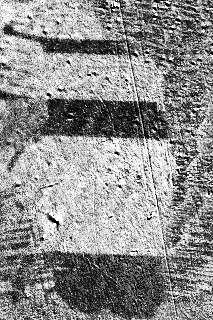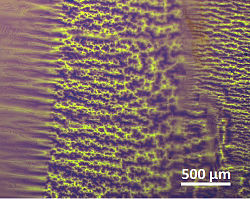Weiss district
As white districts (including Weiss' areas or domains , after the French physicist Pierre Weiss ) is called the magnetism microscopic magnetized domains in the crystals of a ferromagnetic material.
description

In 1907 Weiss recognized that the magnetic moments of the atoms (“ elementary magnets ”) of the ferromagnetic materials are aligned in parallel in limited areas even without the action of an external magnetic field . The size of these areas extends from about 10 to 1000 µm linear expansion. The direction of magnetization is based on the crystal lattice of the material . In the case of materials with a grain size of this order of magnitude or below, all crystallites are single-domain particles , i.e. i.e. not further divided into domains.
The Weiss areas are naturally magnetized to saturation . The boundaries between the districts are called Bloch walls . If a hard magnetic material is exposed to an increasing magnetic field, the Bloch walls initially shift in favor of those Weiss areas that are aligned in the direction of the external field. As the outer field continues to increase, more and more Weiss districts suddenly change their polarity ( Barkhausen jump ). This flipping can be made audible by inductively recording and amplifying the alternating component or the step-like increase in the magnetic field with a coil . When the external field changes, there is hysteresis-related noise, which allows conclusions to be drawn about the magnetic properties of the material.
Weiss districts also occur in analogy to this in ferroelectrics , where they form areas of uniform dipole alignment.
photos
literature
- Franz Zach: Power Electronics - A Manual. 5th edition, Springer Verlag, Wiesbaden, 2015 ISBN 978-3-658-04898-3 .
- Hans Fischer: Materials in electrical engineering. 2nd edition, Carl Hanser Verlag, Munich Vienna, 1982 ISBN 3-446-13553-7 .
- Horst Stöcker: Pocket book of physics. 4th edition, Verlag Harri Deutsch, Frankfurt am Main 2000, ISBN 3-8171-1628-4 .
Individual evidence
- ^ Franz Zach: Power Electronics - A Handbook . 5th edition. Springer Verlag, Wiesbaden 2015, ISBN 978-3-658-04898-3 , pp. 1824 ff .
- ↑ Horst Stöcker: Taschenbuch der Physik . Frankfurt a. M. 1998.




